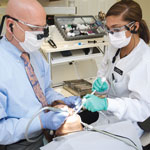
GETTING DOWN TO BUSINESS WITH THE WORLD WIDE WEB.
Consider the Following:
- Have you spent thousands of dollars on a website, only to be unimpressed with its outcome?
- Do you have a website, but haven’t updated it in more than 12 months?
- Do you have a website, but have no idea how it is impacting the public?
- Do you not even have a website?
If you answered “Yes” to any of the above questions, this article is for you. The Internet is the marketing foundation for practices operated by savvy dentists, but it can be a confusing place to promote your practice and brand. Trends on the web are constantly evolving at a feverish pace, which often leads dentists into indecision. In the early stages of Twitter, many marketing gurus encouraged dental practices to sign up for a Twitter account and “tweet” often. Consultants typically recommend that you “tweet” at least three times per day to have impact. Tweeting once a week is just not enough. Most dental practices simply don’t have the time for those daily activities and definitely can’t measure its effectiveness. The trends can cause confusion and intimidation!
Your competition is hoping you feel that way.
So let’s clear up the confusion with some techniques that will build your confidence and improve your online presence.
Websites
If you’re not already online, get there. Do it today! The Internet isn’t going anywhere, but your practice might if you don’t get online. Just think for a minute: what exactly is the real external face of your business? It isn’t the glossy advertisements direct-mailed to the neighborhoods surrounding your business. It isn’t the Little League® shirts emblazoned with your name (although I enjoy supporting local sports teams). And it definitely isn’t the phone book. It is your website! Make the web your single, biggest external marketing piece for your dental practice. According to Forbes magazine, about 80 percent of people use the Internet FIRST to search out businesses in their area. So, if you do not have an online presence, you are automatically limiting yourself to a very small patient population. Even if individuals are referred to you by a friend or colleague, they typically also research your business online to “check you out” before calling. So create a website and get started today!
10 Keys To A Great Website
A website is a great equalizer for dentists in competitive areas. A small, single doctor practice can completely dominate online marketing in an area by creating a great website with relevant content. Make your site engaging, personable and relevant to the client. Choose a simple design with a clean aesthetic layout. Offer a clear and compelling reason for the viewer to visit your office. The online visit is actually the new, “new patient appointment” because online visitors get their first impression of you long before they walk through your practice doors!
Over the years, I have created a list of key elements which attract clients to a website and encourage the development of your brand:
First, start with a web address that matches the name of the area where your office is located. I practice dentistry in Mason, Ohio, so my web address is MasonDentalCare.com. This keeps my website at the top of the results list when a patient looks for a dentist and types “Mason Dentist” into the search field of a search engine. If your practice already has a name, try including the city’s name somewhere in your web address. If your practice is in Boise, Idaho and you have an established name of “Modern Dentistry,” try adding “Boise Modern Dentistry” and choose a website address that reads “BoiseModernDentistry.com.”
Remember, paid advertisements always show up first in the results, usually in an advertising block that is visually distinct from the other sites. You might consider purchasing ad space if your website needs a little help with online visibility. I prefer websites that are part of the organic search results and I almost never click on the advertised or paid sites in the results list. I also choose to not pay for positioning of my brand on search engines. This is a personal preference, but the situation and the competitiveness of your area may dictate otherwise.
Second, stunning images are crucial. Only high quality images belong on your site. Invest in a decent SLR (single lens reflex) camera (no smartphones or compact cameras). As dentists, we invest a lot into dental equipment, but nothing in your armamentarium can give you the return on investment like a good camera.
For images, crop most of the face out, unless it is a full face picture or a smile picture. Crop the lips, cheeks, and gingiva out of the image as much as possible. When taking the photo, zoom in! Ask your assistants to help with lip retractors and invest in some high quality intraoral mirrors if you don’t have them. Practice taking great pictures with your dental staff as models. Also, train your staff to take great pictures! Images with a dental assistant in the background or dirty instruments behind a patient do not belong on your website. You might laugh, but I’ve seen these images online.
Do not post surgery photos! You may think an image shows a great gingival graft, but the patients won’t appreciate it. Consider the potential “cringe factor” of an image before publishing it online. Use “before-and-afters.” Keep images consistent in size and background lighting. An Arrowhead mentor recommends taking lateral views of veneer cases with the lips in the picture. These are powerful images and can create motivation to action on the part of the patient. Photos sell dentistry—period.
Third, communicate in language that a patient can easily understand. Do not use technical verbiage. Consider your audience when writing content. Keep it simple. It will be a refreshing change for your patients who are likely familiar with the language on overly-technical websites. A baseline rule I use is that if my 10-year-old daughter can’t understand the information, I haven’t simplified it enough.
Fourth, keep the site navigation to no more than three layers. Patients should never click more than three times to get to the information they want to find. Maintain a minimalist approach to your site. Sites can get cluttered and include too much information, which can discourage potential patients. Patients go to the web because of speed and convenience. All dentists have so much information that we want the patient to know, but remember that this is only an initial impression. You don’t need to include every bit of information you have about your practice. Anyone who has gone to a restaurant and looked at a five-page menu knows what I mean—too much of a good thing is indeed too much!
Fifth, extend brand consistency from your website to your logo and office design. Don’t send mixed messages with a business card and a website that utilize different colors, fonts, etc. Patients should know that any literature—whether online or printed—comes from the same company.
Sixth, include a location map on your website for navigation to your office. Verify that it works properly and directs the patient to the correct location. Design a space for patients to enter their address and obtain routing and directions directly to your office. This is the next best thing to picking them up and driving them to your office yourself!
Seventh, your web address should be on every page on your website. This helps with website positioning in search engines. Also include icon links such as Facebook, Google+, Pinterest and other social media platforms on the homepage as you add them to your online marketing strategy. Verify that the hyperlinks connect to your various social media sites.
Eighth, include an area on your site to list your continuing education and other accolades. Keep it updated as you take new courses—this will highlight your commitment to learning and help you stand out from your competition.
Ninth, include links! Link every photo you put online to your website. Link reviews to your website and encourage patients who compliment your staff or your practice to go online and write a review. I use Intuit® Demandforce® for reviews and surveys. I’ve been very happy with both the simplicity of the system and its effectiveness. Demandforce® emails patients and links with your website to put reviews directly on your site after they are written. It doesn’t get any easier!
Tenth, keep your site fresh. Change the homepage photo occasionally to keep the site updated, but don’t change the look of the site dramatically. Keep the brand identity stable! Add content as it becomes available and review and remove stale or old content.
Template, Semi-Custom, and Full Custom Websites
Because there are many different elements to website development, I recommend working with a professional website designer. Although I personally chose to design a fully-customizable site with a professional design group; there are other options. Many website designers can create semi-custom templates that can be modified at reasonable prices.
However, I do not recommend simply putting up a generic, templated website and then ignoring it. You must edit, modify, and change content regularly. If you’re not interested in sinking your teeth into this project, assign it to a staff member who is tech-savvy and ask your website provider for an online tutorial in site editing.
There are two reasons I don’t recommend generic, templated websites: there is usually an overload of information and verbiage that is not written in the language of the patient (too much information is just as damaging as too little), and patients can quickly determine which sites have the look of a premade site. No effort or desire to personally reach your client will show and may result in patients looking elsewhere.
Mobile Sites
The good news about websites is that most are now optimized for mobile platforms, so if someone finds your website on a mobile phone or tablet, they will get a more user-friendly version of your website to navigate. For those who do not have this feature, it is important to create a mobile site for your patients and potential patients. Features are constantly being added to mobile sites to make the user experience easier, faster, and more meaningful. Some examples include: appointment request tabs, dental emergency contact tabs, mobile location maps which direct a patient to your office from their current location, and video explanations of procedures. A few things to consider with mobile sites include:
• The mobile site should be written in HTML coding for optimal viewing.
• The mobile site must correlate to the website in look and feel.
• The mobile site should include things like a shortcut button that people can add to their smartphones and tablets when they want to navigate your site.
• Don’t overload the mobile site with too much information.
Keep it very basic.
Build Relationships
Our business is a relationship-building business. Everyone on my staff contributes to the success of our relationships. Your online presence should build relationships, too. Have fun with this! And be patient. Great relationships take time to build and online relationships are no different.









